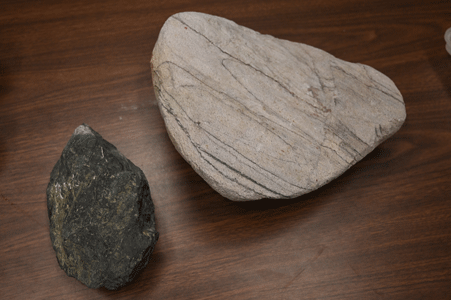Teaching Density
Density is mass divided by volume. d=m/V or ρ=m/V
But what does that mean?
The simple answer is how heavy something is for its size. If something seems very heavy for its size (like a heavy metal object), we say it is more dense. If something seems light for its size (like a bag of cotton or pumice rock), then we say it has low density. Mass is the amount of matter in an object. Volume is how much space the object takes up. The mass is often called the weight of an object on Earth. It will weigh a different amount somewhere else in the universe. However, it will be made of the same amount of matter.
The more technical answer is that density is the physical property of an object in which the average density of the object is the total mass divided by the total volume. The mass of the object is the quantitative measure of inertia on the object. This differs from the weight of an object which is the force exerted on an object by gravitational forces. Volume is the quantity of three-dimensional space that an object occupies.
The units for density can be g/cm3 or kg/m3
Many processes on Earth can be attributed to the interaction of objects of different densities. Some examples include the weather and air currents, the ocean currents, and Plate tectonics.
Convection currents in the model are driven by the less dense hot water rising and the more dense cold water sinking.
The Tape Square
This can be physically modeled in the classroom by making two squares on the floor with tape. Make one square half the size of the first square. Have some students stand in the first square. Have the same number of students stand in the second square. They both have the same number of students but the smaller one takes up less space. The one that is more compact is denser.
Density straw activity
Video showing how to set up and teach the activity.
Learning Objective:
- Students will understand and compare the density of liquids.
- 4- one-gallon jugs (you will want to make 3-4 set up for morning cashless and change the order in the afternoon)
- Salt
- Clear straws
- Plastic cups 4 per group
- Smaller plastic cups
- Sponges or towels for spills
- A mop
- 1/4 measuring cup
- Food coloring (I get the bottles from GFS)
- Take 4 empty one-gallon jugs and put 1/4 cup of salt in one, 1/2 cup of salt in one, 3/4 cup of salt in one, and no salt in the last one.
- Add different colors of food coloring to each one. If you don’t add enough, they will be too light in color. I try to avoid having the no food coloring a dark color. Also, try not to use the order of the rainbow.
- Pour out enough cups of each color for every group to have all four colors.
- Show the class a straw and tell them that their mission is to get all four colors stacked in the straw with no foreign objects and no air gaps between the colors.
- Have each group get one cup of each color, one straw for each person in the group, and an empty cup to use as a dump cup.
- Allow students to work for a while before interrupting them.
- Class hints:
- Stop the class and have everyone step back and keep their hands empty for this part. Ask for volunteers to explain (not show) how they got 1 color in the straw. Then ask volunteers to explain how they got 2 colors in the straw.
- I go around and ask groups if they fill the straw all the way (as high as they can in the cup), will they be able to add more easily?
- Once a group gets all four colors in the straw, I tell them to find the other order that works. It generally keeps them busy for a few.
- After a few groups get the order. I keep telling them to find the other order. This can be fun as I give the class a hard time about none of them finding another way to do it.
- After a group understands and can either prove to me or explain why there can only be one, I stop the class and we discuss the concept.
- I like to tell them that this lesson is indeed all about density and that density is my favorite thing in the world. I put a ‘d’ on the board and make a heart around it. I then ask them if their favorite thing is also density. When told no, I pout and put a line through it like a broken heart.
- I then smile and write d=m/v A small pause then someone will ‘get it’
- Discuss density and have groups explain what is going on using the terms “more dense than” and “less dense than”.
- I then hold up 2 containers: one with cotton balls and one with sand. I hold them out and have the class explain.
- I then hold up pumice and basalt and ask them to explain in terms of density.
- I then hold up 2 different-sized pieces of wood from the same board and ask which is more dense.

These two rocks have the same mass but different volumes.